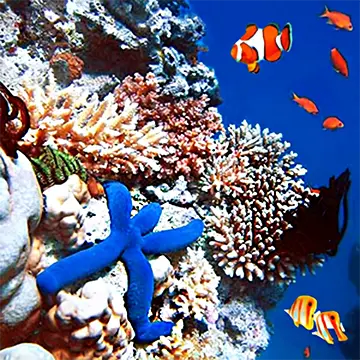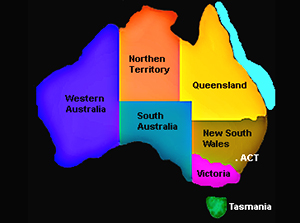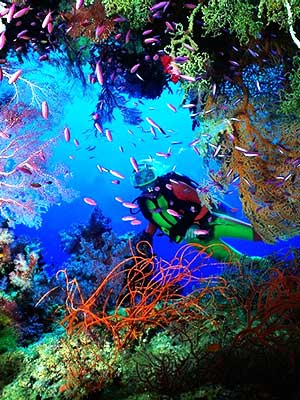The Great Barrier Reef

The Great Barrier Reef is the largest coral reef in the world. It is made up of over 2,900 coral reefs and 600 idyllic islands that stretch for 2,300 km along the north-eastern coast of Queensland, Australia in the Coral Sea in the Pacific Ocean. It is as big as Germany or Japan and half as large as Texas. It is so large that it is the only living organism on the planet that is visible from outer space.
The Great Barrier Reef ecosystem has the most diverse range of underwater animals found anywhere in the world. This world heritage site has many attractions and things to do such as snorkelling, scuba diving, swimming, sailing, whale and dolphin watching, and lots more. Over five million tourists visit the area each year to enjoys these wonders of nature.
25 Great Barrier Reef Facts
- The Great Barrier reef is the largest coral reef in the world.
- It is located off the north-eastern coast of Australia.
- The Great Barrier Reef is 2,600km long.
- It is made up of 2,900 reefs and 900 islands.
- The total area of the Great Barrier Reef is 344,000 sq kilometres.
- It is as big as Germany or Japan and half as big as Texas.
- The reef structure is made of the solid, calcified remains of trillions of dead coral.
- These have accumulated over thousands of years.
- Only the topmost layer of the coral reef is alive.
- Coral may look like plants, but they are actually animals called coral polyps.
- Coral polyps are closely related to jellyfish and sea anemones.
- An individual polyp has a tubular body with tentacles surrounding the mouth at the upper end.
- They can live individually or on large colonies containing thousands of polyps.
- These coral structures provide an ideal environment for other animals.
- Over 5,653 species of animals live in the Great Barrier Reef.
- This includes 1625 species of fish, 3000 species of molluscs, 630 varieties of echinoderm, 14 types of sea snakes, 215 species of birds, 6 species of marine turtle, 30 species of whales and dolphins, 133 species of sharks and rays, and the rare dugong.
- The first European the 'discover' the Barrier Reef was the British explorer James Cook.
- He accidentally grounded his ship on the reef and damaged it severely.
- Matthew Flinders, who first survey it, called it the Extensive Barrier Reef.
- Over time this name morphed into The Great Barrier Reef.
- The present reef is 6,000 to 8,000 years.
- The Great Barrier Reef is a very sensitive ecosystem.
- Increasing water temperatures caused by climate change threatens this reef.
- Careless humans also cause significant damage to the reef.
- About 5 million tourists visit the reef each year.
Great Barrier Reef Location, Size & Map Where is the Great Barrier Reef Located?

Photo: Great Barrier Reef map (marked in light blue)
The Great Barrier Reef (marked in light blue on the map) is located between 15 to 150 kilometres off the north-eastern coast of Queensland, Australia in the Coral Sea in the Pacific Ocean. It extends from the tip of Cape York Peninsula in the north to Bundaberg in the south.
The Great Barrier Reef is 2,300 km (1,450 miles) long. This is about the same distance along the west coast of North America, starting at Vancouver and ending in San Diego. The width of the reef varies from between 60 to 250 kilometres wide. To provide a scale of the sheer magnitude of this reef, the Belize Reef in the Caribbean, which is the second longest reef in the world, is just 290 km in length.
The total area of the Great Barrier Reef is 344,000 sq kilometres. It has an average depth of 35 meters in its in-shore waters. The outer reefs extend over 2,000 metres. Coral, however, do not live at these great depths. In terms of size, it is as big as Germany or Japan and half as big as Texas. It is so large that it is the only living organism on the planet visible from space.
Structure of The Great Barrier Reef What is the Great Barrier Reef Made of?

Photo: Life on the Barrier Reef
Coral reefs, such as The Great Barrier Reef, are natural underwater ecosystems built from calcium carbonate structures made from the accumulation of the bodies of billions of tiny animals known as coral polyps. In fact, most of the coral structure is made up of the calcified remains of dead coral polyps. Only the topmost layers are alive. With the right amount of sunlight, water conditions and temperature, and over long periods of time, corals form the structures that make up the beautiful reefs we see today.
Photo: Coral polyp
While corals may appear like plants, they are actually made up of colonies of millions upon millions of coral polyps. These coral polyps are closely related to jellyfish and sea anemones.
An individual polyp has a tubular body with tentacles surrounding the mouth at the upper end. The polyp lives inside a stony translucent (see-through) limestone case made of calcium carbonate. It constructs this case by extracting calcium from the water.
Corals can live individually or on large colonies containing thousands of polyps. The brain coral, for example, is made up of thousands of little polyps no bigger than the size of a pinhead.
Age of the Great Barrier Reef How Old is the Great Barrier Reef?
Photo: Satellite image of Great Barrier Reef
The age of the Great Barrier Reef is about 6,000 to 8,000 years. The original coral reefs started forming in the Pacific Ocean, in the Coral Sea, sometime between 58 and 48 million years ago. There were many reefs formed and then destroyed and reformed over the ensuing millions of years. When Australia drifted to its present position, the sea levels were altered accelerating the formation of more coral reefs. The current coral reef is believed the have had two major phases of development. The first was about 600,000 years ago. This reef died due to changes in sea level and climate. The second phase started about 20,000 years ago when new coral began to grow on top of the remains of the older reef. As the sea levels rose, at the end of the last glaciation period, the rising seawater started to cover low lying hills along the east coast of Australia. The coral reefs slowly started growing on this newly submerged land. Around 13,000 years ago, the sea level stabilized. The current Great Barrier Reef configuration is about 6,000 to 8,000 years old.
Natural Threats to the Great Barrier Reef Is the Great Barrier Reef Dying?
Photo: Crown of Thrones Starfish eating coral
The Great Barrier Reef is a very sensitive ecosystem. Many natural factors affect its health.
Coral is very sensitive to changes to temperature, nutrient and water quality. Just a 1 to 2 degree change in the water temperature has been known to stress coral and cause coral bleaching. It is feared that global warming may severely impact the reef.
These starfish destroy coral by eating it. It was once thought of as a great risk to the reef but recent research has shown that it is actually native to this habitat and may act as a means of natural population control by eating coral polyps and making room for new coral to form.
Once in about every 17 years or so, crown of thorns starfish appear in plague proportion, denuding vast tracts of the reef. It is thought that these outbreaks are related to increased rainfall and nutrient flows from flooded rivers.
The symbiotic algae which usually resides with the coral can sometimes put a strain on the host causing it to eject the algae. Mass expulsions of the algae is known as coral bleaching (because the algae contribute to coral's colouration). This ejection seems to increase the polyp's chances of dealing with short-term stress. If the stressful conditions persist, the polyp eventually dies. A coral bleaching event in 2002 affected nearly 50% of the coral on the Great Barrier Reef.
Human Threats to the Great Barrier Reef How Humans Damage The Great Barrier Reef
Photo: People walking on coral causing damage
The Great Barrier Reef is a protected wilderness area and a World Heritage Site since 1975. It is strictly managed to minimise human-induced impacts. However, the reef is a popular tourist attraction and straddles an area with significant human commercial activity which invariably results in human environmental damage. There are over 12 ports along the Great Barrier Reef. Over 6,500 large ships also navigate through it each year.
These reefs take thousands of years to form. People can easily damage them by:
• Walking on them
• Dropping anchors on them
• Dragging diving gear over them
• Breaking coral and taking them as souvenirs
• Knocking and grounding boats on them
Fortunately, strict guidelines are presently enforced on all tour operators to ensure the protection of this vital natural asset.
Photo: Stricken ship on Great Barrier Reef
Busy shipping channels traverse the reef and occasionally mishaps occur. Most recently bulk coal carrier Shen Neng 1 ran aground about 70km east of Great Keppel Island damaging its hulk and leaked a quantity of fuel oil into the water (The light blue area in the photograph on the left is caused by sand stirred up by the grounded vessel and not the actual fuel oil which was quickly contained).
Sediments, nutrients, fertilisers, pesticides, toxic chemicals, sewage, rubbish, detergents, heavy metals, and oil run into rivers and out to the Great Barrier Reef, where they can threaten plants and animals on the reef.
How did the Great Barrier Reef get its Name? Who Named the Great Barrier Reef?
Photo: Fish in the Barrier Reef
The Great Barrier Reef was sighted by various European explorers from as early as the 17th century but none of them provided it with a name remembered today.
It was Matthew Flinders, who was the first to survey the entire Australian coastline between 1801 and 1803, who gave it a name that stuck. He actually called it the Extensive Barrier Reef. Over time this name morphed into The Great Barrier Reef.
Great – It is the largest and longest coral reef in the world being over 2,300 kms in length and covering an
area of approximately 344,400 km²
Barrier – The reef acts as massive a natural barrier protecting the coastline and is separated from the coastline
by a deep channel of water.
Reef – A natural underwater ridge just below the surface close to a shoreline is called a reef.
All Rights Reserved. (Last Updated: Feb 22, 2025)